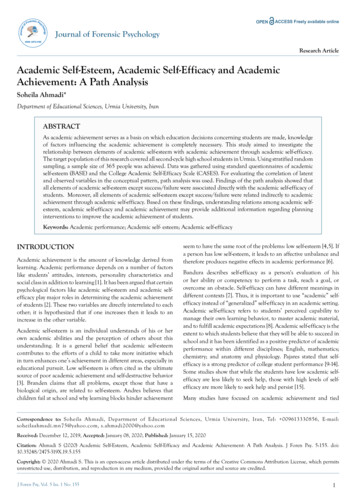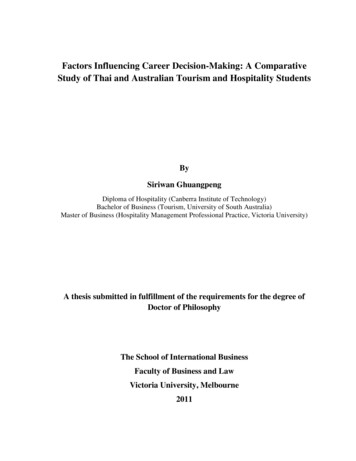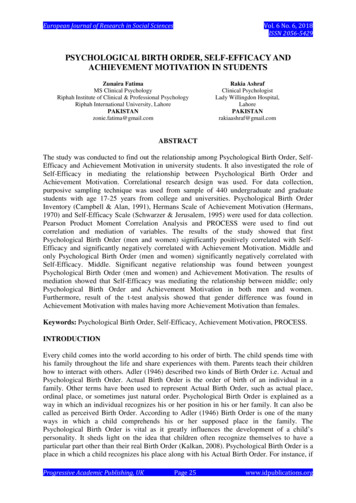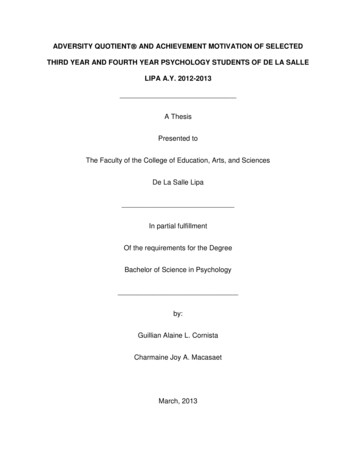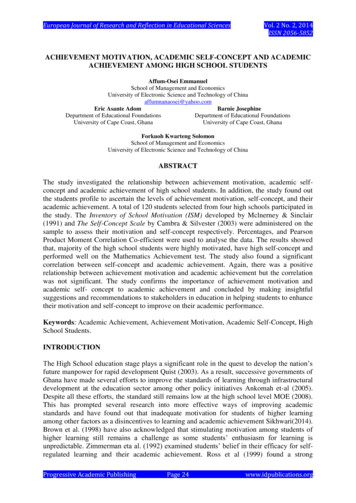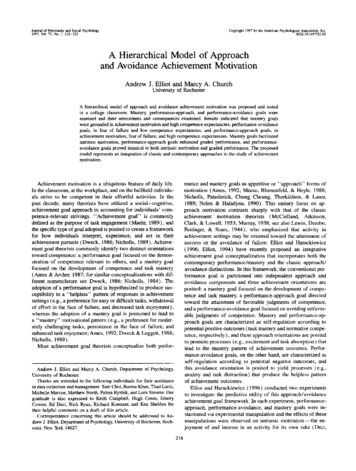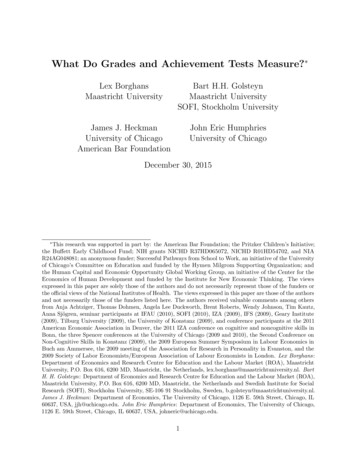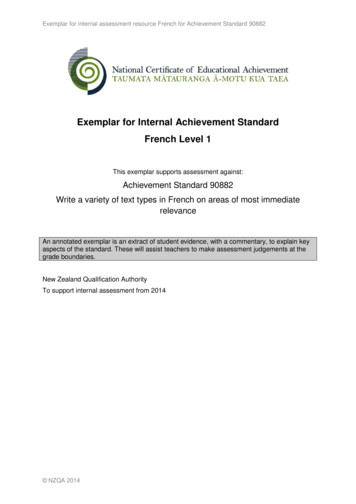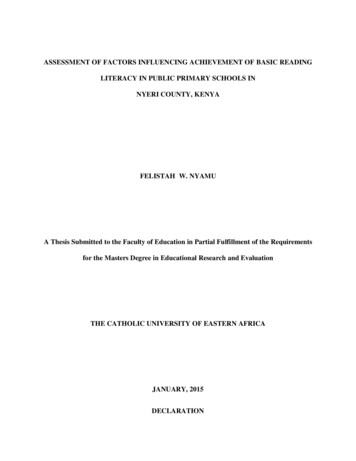
Transcription
ASSESSMENT OF FACTORS INFLUENCING ACHIEVEMENT OF BASIC READINGLITERACY IN PUBLIC PRIMARY SCHOOLS INNYERI COUNTY, KENYAFELISTAH W. NYAMUA Thesis Submitted to the Faculty of Education in Partial Fulfillment of the Requirementsfor the Masters Degree in Educational Research and EvaluationTHE CATHOLIC UNIVERSITY OF EASTERN AFRICAJANUARY, 2015DECLARATION
ABSTRACTThis study was aimed at assessing the factors influencing achievement of basic reading literacyoutcomes in public primary schools in Nyeri County, Kenya. The study was guided by fiveresearch questions generated from literature review. These questions were; to what extent isimplementation of teaching and learning of literacy influencing achievement of basic readingliteracy in public primary schools in Nyeri County? Which factors in the home environment of thepupils are influencing achievement of basic reading literacy in public primary schools in NyeriCounty? To what extent are students’ characteristics influencing achievement of basic readingliteracy in public primary schools in Nyeri County? What challenges are influencing achievementof basic reading literacy in public primary schools in Nyeri County? How can reading literacylevels in public primary schools in Nyeri County be improved? The study adopted Cross-sectionalsurvey design. Head teachers, teachers and class six pupils comprised the target population. Multistage probability sampling technique was used to select the participants. The first stage involvedrandom selection of 39 public primary schools from each of the six constituencies in Nyeri Countyand the second stage involved random selection of participants within the selected schools. Froma representative sample of 39 public primary schools in Nyeri County, a sample of 156 pupils, 78teachers and 39 head teachers was selected. Questionnaires, checklist, and a reading test were usedto collect data. Data collected was analyzed using descriptive and inferential statistics with thehelp of Statistical Package for Social Science version 20. Among the study findings was thatimplementation of teaching and learning of literacy influence achievement of basic reading literacyto a moderate extent. Factors in the pupils’ home environment that influence achievement of basicreading literacy include social economic status, parental educational level, educational resourcesat home and adequate reading literacy activities at home. Students’ characteristics influenceachievement of basic reading literacy to a small extent. Challenges influencing achievement ofbasic reading literacy include inadequate teaching and learning resources, lack of parentalguidance and support and pupils’ lack of motivation. Ways of improving basic reading literacylevels in public primary schools in Nyeri County include increasing the number and variety ofteaching and learning resources, establishment and equipment of school libraries and motivatingpupils to learn.
ACKNOWLEDGEMENTI sincerely thank the Almighty God for enabling me to accomplish this work successfully.I am very grateful to my patient and understanding supervisors Dr. Jared Anyona and Dr. ElizabethNgumbi for their keen eye in helping me shape this work. Their professional guidance, advice andtireless efforts are my inspiration. Special regard goes to my research methods lecturer Dr. PascalWambiya for his insightful instruction and guidance on this research work.I feel indebted to give special thanks to all my family members for their patience andunderstanding especially to my husband Martin Kiai who selflessly supported me throughout theentire work.
DEDICATIONI dedicate this work to my husband Martin Kiai for persistently encouraging me to furthermy studies and eventually supporting me financially to do the same, and to my children Ashley,Elvis and Ryan. May this work be an inspiration to them all, to continue investing their abilitiestirelessly in pursuit of knowledge and academic excellence.
TABLE OF CONTENTSTitle page iDeclaration iiAbstract . iiiAcknowledgement . ivDedication vTable of Contents .viList of Tables . xiList of Figures . xivList of Abbreviations and Acronyms xvCHAPTER ONEINTRODUCTION1.1 Background of the Study 11.2 Statement of the Problem . 61.3 Research Questions 91.4 Significance of the Study 101.5 Scope and Delimitation of the Study . 111.6 Theoretical Framework . 121.6.1 Strength of Social Development Theory 141.6.2 Weaknesses of Social Development Theory . .151.6.3 Application of Social Development Theory in This Study 151.7 Conceptual Framework . 151.8 Operational Definition of Key Terms . . 18
CHAPTER TWOREVIEW OF RELATED LITERATURE2.1 Introduction 192.2 Implementation of Teaching and Learning of Reading Literacy . 192.3 Influence of Home Environment on Acquisition of Reading Literacyskills . 282.4 Influence of Student Characteristic in Acquisition of ReadingLiteracy Skills . . 312.5 Challenges Facing Acquisition of Reading Literacy Skills . . 352.6 How Reading and Literacy Levels Can be Improved . . . 362.7 Summary and Research Gap . . 38CHAPTER THREERESEARCH DESIGN AND METHODOLOGY3.1 Introduction 403.2 Locale of the Study 403.3 Research Design . 403.4 Target Population 413.5 Sample and Sampling Procedures . . .413.6 Description of Research Instruments . 433.6.1 Questionnaire for Head Teachers . . . 443.6.2 Questionnaire for Teachers . . . 443.6.3 Questionnaire for Pupils . . .443.6.4 Checklist . .45
3.6.5. Pupils’ Reading Test . . . 453.7 Data Collection Procedures . 453.8 Validity of Instruments 463.9 Pilot test . . .463.10 Reliability of Instruments 473.11 Data Analysis Procedure 473.12 Ethical Consideration . 49CHAPTER FOURANALYSIS, PRESENTATION, INTERPRETATION AND DISCUSSION OF FINDINGS4.1 Introduction . 504.2 Rate of Return of Data Collection Instruments . .504.3 Demographic Information of Respondents . 514.3.1 Pupils’ Gender and Age . . 514.3.2 Gender of Head Teachers and Teachers . .524.3.3 Work Experience of Head Teachers and Teachers 534.3.4 Head Teachers and Teachers Academic Qualification .554.4. Effective Implementation of Teaching and Learning . 564.4.1 School Climate . 564.4.2 Effectiveness of Teachers and Teaching and Learning Process .614.4.3 Adequacy of Teaching and Learning Resources 674.4.4 Extent of Influence of Implementation of Teaching and Learning onAchievement of Reading Literacy . . 694.5 Pupils’ Home Environment Factors That Influence Achievementof Reading Literacy . . . .72
4.5.1 Social Economic Status of Pupils’ Families . 724.5.2 Availability of Educational Resources at Home . .764.5.3 Adequacy of Literacy Activities at Home . . . 774.5.4 Factors in the Home Environment that Influence Achievementof Basic Reading Literacy . . .4.6 Student Characteristics . .78794.6.1 Extent of Influence of Students Characteristics onAchievement of Reading Literacy . 844.7 Challenges Facing Achievement of Basic Reading Literacy 864.8 How to Improve Literacy Levels . 984.9 Performance in Reading Literacy Test 107CHAPTER FIVESUMMARY, CONCLUSION AND RECOMMENDATIONS5.1 Introduction . 1095.2 Summary of Findings . .1095.2.1 Participant’s Characteristic .1095.2.2 Influence of Implementation of Teaching and Learning . . 1105.2.3 Factors in the Home Environment that Influence Achievement ofReading Literacy . . 1115.2.4 Influence of Students Characteristic On achievement of ReadingLiteracy . . . 1115.2.5 Challenges Influencing Achievement of Basic Reading Literacy 1125.2.6 Ways of Improving Literacy Levels in Public Primary
Schools in Nyeri County . . 1145.3 Conclusion . .1155.4 Recommendations .1165.5. Recommendations for Further Research .117REFERENCES . 118APPENDIX I: Cover letter . . 127APPENDIX II: Questionnaire for Head teachers . 128APPENDIX III: Questionnaire for Teachers . . 135APPENDIX IV: Questionnaire for Pupils . 142APPENDIX V: Checklist . 148APPENDIX VI: Pupils’ Reading Test . 149APPENDIX VII: Institution’s Cover Letter 152APPENDIX VIII: NACOSTI Research Permit . . 153APPENDIX IX: NACOSTI Research Authorization Letter .154APPENDIX X: County Director of Education Research Authorization Letter .155
LIST OF TABLESTable 1: Return Rate of Data Collection Instruments .50Table 2: Distribution of Pupils’ Age 51Table 3: Head Teachers and Teachers’ Gender Distribution . .52Table 4: Head Teachers’ and Teachers’ Years of Work Experience .53Table 5: Head Teachers’ and Teachers’ Years of Work Experience in Current Schools 54Table 6: Head Teachers’ and Teachers’ Highest academic Qualification . .55Table 7: Teachers Response on School Climate Statement . .59Table 8: Methods of Assessing English Teachers . .62Table 9: Teachers In-service Training or Seminars Attendance Frequency 63Table 10: Aspects of Teaching that Hinder Learning . .64Table 11: Teachers’ Practices Hindering Teaching and Learning .65Table 12: Other Relevant Teaching/Learning Resources . .68Table 13: Regression on Implementation of Teaching and LearningModel Summary . 70Table 14: Coefficients of individual variable in implementation of teaching andLearning . 71Table 15: Parents’ Occupation .73Table 16 Parents’ Education Level .74Table 17: Educational Resources at Home 76Table 18: Literacy Activities at Home . .77Table 19: Regression Coefficients on Home Environment Aspects 78Table 20: Well Rested, Alert and Motivated Pupils 79
Table 21: Extent of Pupils’ Behavior Hindering Learning .80Table 22: Pupils’ Rate of Absenteeism .82Table 23: Pupils’ Subject Preference .83Table 24: Pupils’ Characteristics Regression Model .85Table 25: Coefficients of Individual Variable Comprising Students’ Characteristic86Table 26: Head Teachers’ Suggestions on Challenges in Teaching and Learning .87Table 27: Teachers’ Suggestions on Challenges in Teaching and Learning .88Table 28: Pupils’ Suggestions on Challenges in Teaching and Learning .89Table 29: Challenges in Pupils’ Homes 91Table 30: Teachers’ Response on Challenges at Home .92Table 31: Challenges of Pupils’ at Home 93Table 32: Head Teachers’ Opinions on Challenges on Pupils’ Character .95Table 33: Teachers’ Opinions on Challenges on Pupils’ Character . 96Table 34: Pupils’ suggestions on Problems that Hinder their Learning of How to Read.97Table 35: Head Teachers’ Views on How to Improve Literacy Levels .98Table 36: Teachers’ Views on Improvement of Implementation of Teachingand Learning 99Table 37: Pupils’ Opinion on Ways the School can Improve Learning to Read .100Table 38: Head Teachers’ Opinion on Improvement in Pupils’ Home Backgrounds .102Table 39: Teachers’ Opinion on Improvement in Pupils’ Home Backgrounds . 103Table 40: Pupils’ Opinion on Improvement in Their Home Backgrounds .104Table 41: Head Teachers’ Opinion on Improvement of Pupils’ Character .105Table 42: Teachers’ Opinion on Improvement of Pupils’ Character .106
Table 43: Pupils’ Suggestions on How to Improve in Reading .107Table 44: Analysis of Reading Literacy Test Performance . 108
LIST OF FIGURESFigure 1.1: Conceptual Framework .16Figure 3.1: Sampling Matrix .42Figure 4.1: Type of Family House 75
LIST OF ABBREVIATIONS AND ACRONYMSALAAnnual Learning AssessmentANCEFAAfrican Network Campaign for Education For AllECDEEarly Childhood development EducationEFAEducation For AllESOLEnglish as a Second or Other Language.FPEFree Primary EducationICTIntegrated Information TechnologyMDGsMillennium Development GoalsMKOMore Knowledgeable OtherNGONon – Government OrganizationOECDOrganization for Economic Co-operation and DevelopmentPIAACProgramme for the International Assessment of Adult CompetenciesPISAProgramme for International Student AssessmentSPSSStatistical Package for Social SciencesTALISTeaching And Learning International SurveyUNUnited NationsUNESCOUnited Nations Educational Scientific and Cultural Organization.ZPDZone of Proximal DevelopmentNACOSTINational Commission for Science, Technology and Innovation
CHAPTER ONEINTRODUCTION1.1 Background of the StudyLarge numbers of children in East African region are simply not learning; basic readingliteracy outcomes remain significantly deficient despite significant gains in expanding access toprimary education. This is according to survey reports carried out annually by Uwezo East Africa,starting from the year 2009 in Kenya and other East African countries. Though access to educationhas improved worldwide, an estimated 250 million children of primary school age lack basicreading, writing and numeracy skills, whether in school or not (UN, 2013, p.17). The report byUwezo East Africa on the 2011 survey in Kenya revealed that 4 % of class 8 pupils could not reada class 2 story (Uwezo, 2011, pp.14, 16, 18). The Annual Learning Assessment (ALA) carried outin Kenya in February year 2012 by Uwezo revealed that 7% of class 8 pupils could neither passEnglish or Kiswahili reading tests set at class 2 level.Uneducated or out of school children are the next generation of illiterate adults(UNESCO, 2013). A global literacy rates report by UNESCO on year 2011 survey illustrated thatthe lowest literacy rates are observed in Sub-Sahara Africa and in South and West Asia. The reportalso revealed that the regions of South and West Asia are home to more than a half of the globalilliterate population (53%). In addition 24% of illiterate adults live in Sub-Sahara Africa, 12% inEast Asia and the Pacific, 6.2% in Arab States and 4.6% in Latin America and the Caribbean. Itwas estimated that 20% of the remaining global illiterate population live in the remaining regionscombined (UNESCO, 2011, p. 66).According to a National Research Council based in United States, (1998, 2001, 2002),early childhood is a critical time for skills development and emphasizes the centrality of literacy
as foundational of later success. Acquisition of basic reading literacy skills is better achievedduring the early years of life. According to Wolf (2007), a child’s first five years initiate reading’sinterrelated processes, and even infants can be viewed as emerging pre-readers. Paris (2005)demonstrated that language and literacy skills can be constrained or unconstrained based onwhether they develop over a short period of time, or a long period of time. Teale, Paciga, andHoffman (2010) add that the roots of language and literacy skills in early childhood cannot bedisregarded.Sensenig (2011) noted that the skills that become highly important in the third and fourthgrade rely on rich interactions with print that begin much earlier which is why a narrow focus onbasic decoding is especially detrimental for children. The literacy levels at a young age can predictthe growth of literacy skills in future development (OECD, 2012). There is strong evidence thateducation has a substantial causal effect on basic literacy and formal schooling is the dominantdeterminant of this skill (Green & Riddlell, 2012). This indirectly emphasizes the reason whyeducational stakeholders have a cause to worry if formal education during the early years is noteffective in enhancing basic literacy skills.Basic reading literacy is one of the essential underpinning skills that enable people to beproductive in their work, to continue to learn and develop, and to participate fully in society(Industry Skills Councils of Australia, 2011). The same councils (NSCs), add that language,reading literacy skills are fundamental to improved workforce participation, productivity andsocial inclusion and that their impact cannot be overstated. These core skills are crucial to highereducational outcomes which in turn lead to higher workforce participation and higher productivity.Low scale proficiency reading literacy is associated with negative outcomes such aslower wages, greater chances of unemployment and disengagement from the labour market
(OECD, 2012). Given the evolution of the labour market and the growing penetration of ICT in allareas of life plus related changes in delivery of many services for example online banking, Egovernment, electronic shopping just to mention a few, low scale proficiency literacy is an issuefor policy makers.Abdzi (2004), in a concern to address the issue of adult illiteracy noted that the effect ofliteracy on people’s quality of life, health, fertility and productivity are well known when thesehave been acquired in primary school. She added that people who have not gone to school performless well in essential memory tasks linked to decision making; recalling a series of digitsbackwards and forward, remembering list of words, reproducing a short story or complex shapes,using readily available data for deductive reasoning. These abilities are developed in the first threeyears of primary school. She adds that the first three grades of schooling seem to have the mostsignificant effect on these cognitive variables.In the year 2000, the United Nations established eight international development goalsduring the Millennium Summit following the adoption of the United Nations MillenniumDeclaration adopted from the General Assembly which was held on September 6 th to 8th in theyear 2000 at the United Nations headquarters in New York. These goals are referred to as theMillennium Development Goals (MDGs). All the 189 United Nations member states and at least23 international organizations committed themselves to help achieve these goals by year 2015. By2015, 2/3 of adults and ¾ of youth in Sub-Sahara Africa are expected to be able to read and write(UNESCO, 2008, p.11).Millennium Development Goal 2 seeks to achieve universal primary education by 2015,and stipulate that Children everywhere, boys and girls alike, should be able to complete a fullcourse of primary schooling (UN, 2013). According to the United Nations Millennium
Development Goals Report (2013) , enrolment in developing regions (Kenya belongs here) hadreached 90% in year 2011 up from 83% in year 2000 (UN, 2013, p. 15). This indicates progressthough at a slow pace. The report further added that abolition of school fees at primary level ledto a surge in enrolment which in turn brought a new set of challenges. The same report concludesthat if the current trends continue, the world will not meet the goal of universal primary educationby 2015.The UN 2013 report also revealed that 123 million youth aged between 15 years to 24 yearsglobally lack basic reading and writing skills (UN, 2013, p. 14). The total global adult literacyrates are 84%. The illiterate adult population was 773.5 million. Youth literacy rate was 89.5%.Youth illiterate population was 123.2 million (UNESCO, 2013, p. 9). The UNESCO Institute forStatistics on Adult and Youth literacy (2013), report illustrated that the lowest literacy rates byyear 2011, were observed in Sub-Saharan African and in South and West Asia. South and WestAsia had more than a half of the global illiterate population (53%). Sub-Saharan Africa had 24%of illiterate adults (UNESCO, 2013, pp.10-12). Adult literacy can be improved to 100% if theefforts are concentrated in the early years of primary schooling.According to Wachira (2013), when reporting for Standard Digital news (2013, October9th), parents in Kenya, Tanzania and Uganda must start facing the hard facts that their children inschools are not learning; children are not acquiring basic reading skills during their early years ofprimary education. The news reporter was quoting from a comprehensive study undertaken byUwezo East Africa which is an initiative that promotes access to information and improved servicedelivery across the region.Since 2009 Uwezo East Africa has been carrying out Uwezo Learning Assessmentssurveys in East Africa on literacy and numeracy levels. The year 2011 survey covered 320 Districts
which are about 90% of all the Districts in East Africa, 9,298 schools, and 151,316 householdsand involved 348,384 children (Uwezo East Africa, 2011, p. 7). The survey report revealed thatvast majority of pupils were not acquiring basic competencies during the early years of primaryschooling as expected in the national curricula. More than two out of every three pupils enrolledat standard 3 level in East Africa failed to pass basic tests in English, Kiswahili or numeracy set atstandard two level. Only 32 % of class three pupils could pass reading test in Kiswahili set atstandard two level and 16% in English reading test. Two out of 10 children in standard 7 in EastAfrica did not have standard two level reading literacy competencies (Uwezo East Africa, 2011,pp.11-12). Kenyan children outperformed children from the other East African countries in alltests (Uwezo East Africa, 2011). The situation was worse among the poor, where children fromsocially and economically disadvantaged households performed poorly in all areas in comparisonto their counterparts from affluent backgrounds.Uwezo Kenya carried out Annual literacy Assessment in the year 2011 that covered 124out of 158 Districts, 72,106 households and involved 134,243 children between ages 6-16 years(Uwezo Kenya, 2012, pp.2-3). The report revealed that 4% of class 8 pupils could not read a class2 story. Class six pupils who did not pass the reading literacy test were 18%. Also revealed wasthat only 3 out of 10 children in class 3 could read class 2 story and one out of ten children in class4 and 5 could not comprehend a class 2 story even when they could read it. Only 3 out of 10children in class 3 could read a class 2 hadithi (story in Kiswahili language). There are 4 out of100 children in class 8 who could not read a class 2 level hadithi (Uwezo Kenya, 2011, pp.16, 18)Nyeri County was among the regions in Kenya that was doing relatively better comparedto other counties in Kenya; it ranked second after Nairobi in acquisition of basic literacy skillsamong children (Uwezo Kenya, 2011). This better performance of Nyeri county was however only
relative. In overall terms, it remained a case of low literacy achievement among the pupils.According to the Uwezo report (2012), class 3 pupils who could read hadithi were 48.91%compared to a national average of 32.9%. Class 3 pupils who could read a story were 42.39%compared to a national average of 27.2%. The hadithi and the story were set at class two level ofprimary education (Uwezo Kenya, 2011, pp.59).Though the above report was disheartening to educational stake holders, Uwezo Kenyafelt that the schools and districts that performed relatively better constituted a potential source ofsolution on how to improve children’s learning. They added that there is an opportunity to helpevery child learn in East Africa. Hence this study was an attempt to assess those factors thatinfluence learning outcomes in basic reading literacy and numeracy skills in public primaryschools in Nyeri County in order to form a base for improvement interventions which may also bereplicated in other counties to enhance basic reading literacy and numeracy. Of importance wasthat achieving gains in education would have an impact on all the Millenniums Development Goals(UN, 2013).1.2 Statement of the ProblemThe purpose of this study was to assess the factors influencing achievement of basicreading literacy in public primary schools in Nyeri County. There was an outcry on the low readingliteracy levels witnessed among school going children in primary schools by various educationstakeholders. Uhuru Kenyatta, the president of Kenya (2013) being one of the concernedstakeholders, in his speech at the opening of the Primary School Head Teachers’ 9th AnnualDelegate Conference for 2013 at Sheik Zayyed Children’s Center, made the following remarks:Statistics showing that less than 50% of teachers have any actual contact with their pupils,or that most children remain both illiterate and innumerate at the end of primary school,
spell a problem for the country This situation cannot and will not persist further, becauseit is a reprehensible disservice to our children In the interest of accountability, anexplanation for the rise in these disturbing statistics is overdue (President Speech, 2013,3rd Sept, para.1, 3)Obala (2013), reporting on the launch ofUwezo Kenya-2012 Literacy and NumeracyReport’ on 23rd July 2013 at Kenya Institute of Curriculum Development, summarized the call ofKenyan Leaders for educationists to tackle the learning crisis urgently. “Various stakeholders haveacknowledged that there is a serious crisis in the education sector that must be addressed urgently,following a damning report that suggested many Class Eight candidates can barely read or write”(Obala, 2013, para. 1). She was summarizing the concerns of Educational stakeholders whoincluded the Vision 2030 Director- General Mugo Kibati, Baringo Governor Benjamin Cheboi andthe Chairperson of the National Assembly committee on Education, Sabina Chege (2013) whowere in attendance during the Launch of 2012 Literacy and Numeracy Report by Uwezo Kenya.While there was evidence that reading literacy rates were low, there are few studiesempirically conducted to examine the contributing factors to this phenomenon particularly inKenya. The various research studies conducted in Kenya by Uwezo Kenya are concerned with therates of reading literacy. There is an information gap on the factors that contribute to the observedlow reading literacy levels that this study will attempt to fill.Industry Skills Councils in Australia (2011), reported that some employers feel let downby the school system. The employers attribute the problem of having a significant number ofemployees with low numeracy and literacy skills to a grand scale failure of the school system. UNMillennium Development Goals Report (2013), Uwezo East Africa (2011), and Uwezo Kenya
(2011) among others, confirm that the reading literacy levels among school going children inAfrican countries are way below the expected standards.When reporting for digital news, Obala (2013) reported that leaders want learning inKenya tackled. She added that various stakeholders had acknowledged that there was a seriouscrisis in the education sector that needed to be addressed urgently, following a damning report thatsuggested many class eight candidates could barely read or write. The stakeholders concernedincluded the vision 2030 Director- General Mugo Kibati, Baringo Governor Benjamin Chemboiand the chairperson of the National Assembly committee on Education, Sabina Chege. Obala(2013) argued that it was not enough that the government concentrate on increasing enrolment andteacher recruitment without addressing the issue of quality in education. Mugo (2013), the vision2030 Director General, added that there was need for a radical shift to look at learning outcomes.As such, there was a dire need to empirically analyze the factors influencingachievement of learning outcomes in basic education which include reading literacy in the country.Knowledge of these factors would help to mount appropriate interventions to address the problemof lack of reading literacy among the children who are graduating from primary schools.Achievement of reading literacy skills will in turn not only help to achieve MillenniumDevelopment Goal 2, but also, all the other seven MDGs as literacy is a major backbone ofdevelopment.Sifuna (2006) postulated that implementation of free primary education in Kenya was nota well thought out plan which did not include a prior situation analysis and this led to poor qualityeducation as a result of overcrowding, lack of teachers and learning materials among otherproblems. Machila (2005) in a study on factors affecting effective implementation of free primaryeducation identified availability and quality of teaching and learning resources as some of the
factors. Sifuna (2006) and Machila (2005) studies were addressing primary school education as awhole and therefore there is an information gap on whether these factors of inadequate teachersand teaching and learning resources influence achievement of reading literacy in public primaryschools. This study sought to find out if the challenges of
ASSESSMENT OF FACTORS INFLUENCING ACHIEVEMENT OF BASIC READING LITERACY IN PUBLIC PRIMARY SCHOOLS IN NYERI COUNTY, KENYA FELISTAH W. NYAMU A Thesis Submitted to the Faculty of Education in Partial Fulfillment of the Requirements for
